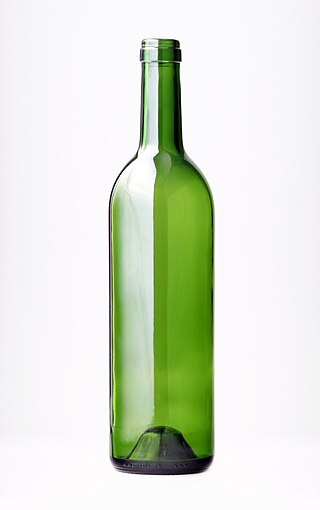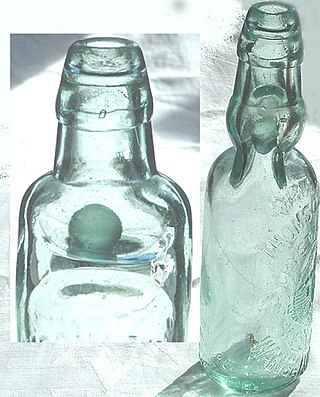
Draught beer, also spelt draft, is beer served from a cask or keg rather than from a bottle or can. Draught beer served from a pressurised keg is also known as keg beer.

Real ale is the name coined by the Campaign for Real Ale (CAMRA) for beer that is "brewed from traditional ingredients, matured by secondary fermentation in the container from which it is dispensed, and served without the use of extraneous carbon dioxide".

A soft drink is any water-based flavored drink, usually but not necessarily carbonated, and typically including added sweetener. Flavors used can be natural or artificial. The sweetener may be a sugar, high-fructose corn syrup, fruit juice, a sugar substitute, or some combination of these. Soft drinks may also contain caffeine, colorings, preservatives and other ingredients.

Homebrewing is the brewing of beer or other alcoholic beverages on a small scale for personal, non-commercial purposes. Supplies, such as kits and fermentation tanks, can be purchased locally at specialty stores or online. Beer was brewed domestically for thousands of years before its commercial production, although its legality has varied according to local regulation. Homebrewing is closely related to the hobby of home distillation, the production of alcoholic spirits for personal consumption; however home distillation is generally more tightly regulated.

Ginger ale is a carbonated soft drink flavoured with ginger. It is consumed on its own or used as a mixer, often with spirit-based drinks. There are two main types of ginger ale. The golden style is credited to the Irish doctor Thomas Joseph Cantrell. The dry style, a paler drink with a much milder ginger flavour, was created by Canadian John McLaughlin.

A bottle is a narrow-necked container made of an impermeable material in various shapes and sizes that stores and transports liquids. Its mouth, at the bottling line, can be sealed with an internal stopper, an external bottle cap, a closure, or induction sealing.

Carbonated water is water containing dissolved carbon dioxide gas, either artificially injected under pressure or occurring due to natural geological processes. Carbonation causes small bubbles to form, giving the water an effervescent quality. Common forms include sparkling natural mineral water, club soda, and commercially produced sparkling water.

A drink can is a metal container designed to hold a fixed portion of liquid such as carbonated soft drinks, alcoholic drinks, fruit juices, teas, herbal teas, energy drinks, etc. Drink cans are made of aluminum or tin-plated steel. Worldwide production for all drink cans is approximately 370 billion cans per year.

Effervescence is the escape of gas from an aqueous solution and the foaming or fizzing that results from that release. The word effervescence is derived from the Latin verb fervere, preceded by the adverb ex. It has the same linguistic root as the word fermentation.

A closure is a device used to close or seal a container such as a bottle, jug, jar, tube, or can. A closure may be a cap, cover, lid, plug, liner, or the like. The part of the container to which the closure is applied is called the finish.

A keg is a small cask.

Kegerator, a portmanteau of the words keg and refrigerator, is a refrigerator that has been designed or altered to store and dispense kegs.

Beer head is the frothy foam on top of beer and carbonated beverages which is produced by bubbles of gas, predominantly carbon dioxide, rising to the surface. The elements that produce the head are wort protein, yeast and hop residue. The carbon dioxide that forms the bubbles in the head is produced during fermentation as yeasts break down sugar-rich molecules to produce ethanol and carbon dioxide. The carbonation can occur before or after bottling the beer. If the beer continues fermenting in the bottle, then it naturally carbonates and the head is formed upon opening and/or pouring the beer. If the beer is pasteurized or filtered then the beer must be force carbonated using pressurized gas.

A soda gun or bar gun is a device used by bars to serve various types of carbonated and non-carbonated drinks. A soda gun has the ability to serve any beverage that is some combination of syrup, water and carbon dioxide. This includes soft drinks, iced tea, carbonated water, and plain water. When served from a soda gun, these are often known as fountain drinks.

A widget is a device placed in a container of beer to manage the characteristics of the beer's head. The original widget was patented in Ireland by Guinness. The "floating widget" is found in cans of beer as a hollow plastic sphere, approximately 3 centimetres (1.2 in) in diameter with two small holes and a seam. The "rocket widget" is found in bottles, 7 centimetres (2.8 in) in length with the small hole at the bottom.

The soda siphon, also known as the seltzer bottle, siphon seltzer bottle, or just siphon) is a device for storing and dispensing carbonated beverages while maintaining the internal pressure, thereby preventing it from going flat. The carbonated beverage is dispensed using the internal pressure of the bottle, so the setup is not a true siphon in its operation.

A Fizz-Keeper is a type of closure that is marketed as a way to keep carbonation in soft drinks. It consists of a small round hand pump that is screwed onto the top of a plastic soft drink bottle, which is then used to pump air into the bottle, preventing the drink from going flat.

Premix and postmix are two methods of serving soft drinks—usually carbonated—that are alternatives to bottles and cans.

A Codd-neck bottle is a type of bottle used for carbonated drinks. It has a closing design based on a glass marble which is held against a rubber seal, which sits within a recess in the lip.

A soda machine or soda maker is a home appliance for carbonating tap water by using carbon dioxide from a pressurized cartridge. The machine is often delivered with flavorings; these can be added to the water after it is carbonated to make soda, such as orange, lemon, or cola flavours. Some brands are able to directly carbonate any cold beverage.




















